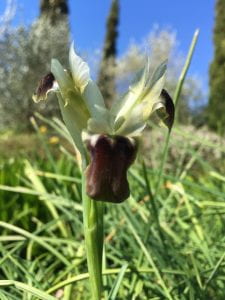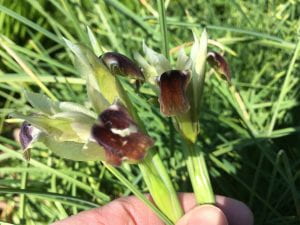By Nick Wray
 The early spring blossom is in full swing with white, pink and yellow blooms appearing everywhere, so it seems a little subdued to talk about a black flower. Its name also is somewhat sombre. Widow Iris, Iris tuberosa is one of only a few flowers of the 400,000 species of plants on the planet with black flowers. Or at least that’s how they seem to the human eye. In fact, there are no truly black flowers as there are no plant pigments that are black. The black part of the flower, its sepals (known as falls in Iris) are saturated in anthocyanins and the part of the light spectrum reflected back at us gives a black colour (or at least the appearance of one). Secondly, this colour only appears on the sepals, with petals in various shades of green, olive and brown. This combination, like is common name, is powerful and makes for a charming plant, if a little difficult to spot in the garden. But persistent tubers ensure that it appears in winter with linear grass-like foliage that is quadrangular in section (the only Iris to do so), followed in March by the extraordinary flowers. Warmth and shelter are what this curiosity needs, to mimic its Mediterranean home and a summer baking. From France across the countries that make up southern Europe to Turkey, mild winters and warm springs allow this extraordinary iris to establish. The base of a sunny wall or in a sunny grassy bank with spring bulbs, full light and full sun in summer and patience for plants to bulk up and this black sheep of the Iris world will make your garden its new home.
The early spring blossom is in full swing with white, pink and yellow blooms appearing everywhere, so it seems a little subdued to talk about a black flower. Its name also is somewhat sombre. Widow Iris, Iris tuberosa is one of only a few flowers of the 400,000 species of plants on the planet with black flowers. Or at least that’s how they seem to the human eye. In fact, there are no truly black flowers as there are no plant pigments that are black. The black part of the flower, its sepals (known as falls in Iris) are saturated in anthocyanins and the part of the light spectrum reflected back at us gives a black colour (or at least the appearance of one). Secondly, this colour only appears on the sepals, with petals in various shades of green, olive and brown. This combination, like is common name, is powerful and makes for a charming plant, if a little difficult to spot in the garden. But persistent tubers ensure that it appears in winter with linear grass-like foliage that is quadrangular in section (the only Iris to do so), followed in March by the extraordinary flowers. Warmth and shelter are what this curiosity needs, to mimic its Mediterranean home and a summer baking. From France across the countries that make up southern Europe to Turkey, mild winters and warm springs allow this extraordinary iris to establish. The base of a sunny wall or in a sunny grassy bank with spring bulbs, full light and full sun in summer and patience for plants to bulk up and this black sheep of the Iris world will make your garden its new home.
 Pollination is done on warm days with the dark colour of the sepals heating up quickly in the morning sun. Pollination is exclusively by Hymenoptera comprising the; sawflies, wasps, bees, and ants, with Mining bees Andrena, being the principal pollinator. Flowers are sweetly scented, and the dark colour absorbs the suns heat providing an additional attractant for pollinators.
Pollination is done on warm days with the dark colour of the sepals heating up quickly in the morning sun. Pollination is exclusively by Hymenoptera comprising the; sawflies, wasps, bees, and ants, with Mining bees Andrena, being the principal pollinator. Flowers are sweetly scented, and the dark colour absorbs the suns heat providing an additional attractant for pollinators.
In the Botanic Garden, the Widow Iris can be found flowering now in the Mediterranean Climatic Region of Europe & North Africa display, with a large patch of 38 blooms behind the Garigue interpretation board. We have a few pots in the warm temperate glasshouse as insurance against very harsh winters. Penny Harms our Glasshouse Coordinator is a Scillonian where she grew up on St Marys, the largest of the five inhabited islands. She can remember picking Widow Iris as a cut flower crop and remembers them being grown on a few small farms with sheltered South facing fields. The larger growers concentrating on the lucrative Narcissus Soleil d’ Or daffodils. The early flowers provided an important income for Scillonian farmers who have harvested the first flowers of the season sending their blooms to the big markets in London and Birmingham for nearly 150 years.
Today, Widow Iris is available at nurseries and online, so you too can have a sunny patch of your garden with these unusual, but somewhat seductive flowers.


I have a large patch of these irises which have self sown into a shady patch under trees. The original patch is the other side of a wall about 10 yards away in the sun. Curious.